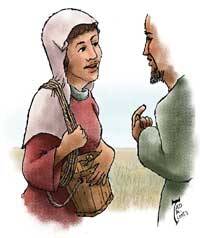Spiritual Thirst
“Where then can we get this living water?” (Jn 4:11)
• Imagine yourself as a thirsty and hungry Israelite in the wilderness. What do you want from Moses and God?
• What makes possible the progression in faith regarding Jesus in John 4? What role does the Samaritan woman play?
• How does your own experience of thirst help you to understand Paul’s dynamic of faith, hope and love?
Todays reading from Exodus 17 concerns the wilderness generations thirst for fresh drinking water and wholesome food. Having escaped from slavery in Egypt, the people grumble against Moses and his failure to supply them with food and drink. They murmur against Moses and indirectly against God, when they ask: Why did you ever make us leave Egypt? Was it just to have us die here of thirst? Their rebellion at Massah and Meribah (these place names mean testing and rebellion, respectively) becomes in Psalm 95 the main illustration of ancient Israels failure to trust in Gods loving care. Eventually, through Gods miraculous intervention, Moses supplies living water for the people in the wilderness.
The long narrative about the encounter between Jesus and the Samaritan woman from John 4 also concerns thirst and living water. It takes place at the well near Shechem, the Samaritans traditional place of worship. Here the water is what Jesus reveals about himself and his heavenly Father. From Jesus request for a drink of water, the conversation moves in the direction of the living water, spiritual worship and true food that Jesus alone can provide.
The structure of the narrative is intricate. First Jesus converses with the Samaritan woman. Next he promises living water. Then the woman identifies him as a prophet. The center of the account is Jesus affirmation that salvation is from the Jews (his people) and that soon God will be worshiped in spirit and truth. Then the story goes into reverse. The woman identifies Jesus as the Messiah. Next Jesus promises true food. Finally Jesus converses with Samaritans. This kind of structure is called concentric, and it appears frequently in the Bible and in other ancient writings.
Here Jesus deals openly and compassionately with Samaritans, persons regarded by Judeans and Galileans as at best marginally Jewish. And a Samaritan woman with a dubious past becomes the instrument by which Jesus message is conveyed to other Samaritans. In Johns Gospel she in effect serves as the first Christian missionary when she tells others about Jesus.
The Johannine narrative also bears witness to a dramatic progression in faith regarding Jesus. The woman first identifies Jesus as a Judean, like many others in their time. Next, when Jesus correctly tells the woman about her past, she identifies him as a prophet. Then the woman begins to suspect that he might be the Messiah. Finally, after other Samaritans converse with Jesus for two days, they declare that he is the savior of the world.
Moreover, at the center of the Johannine narrative Jesus promises a new kind of worship in spirit and truth. Early in the story he promised to give living water, and later on he speaks about my food. Christian readers will naturally make connections with baptism and the Eucharist. This worship in spirit and truth, rooted in and faithful to ancient Israels traditions, is inextricably connected with the person of Jesus and is open to all kinds of persons.
Paul's reflection on Christian hope in Romans 5 can help us understand better the dynamic of spiritual thirst. It shows how faith, hope and love work together and form the framework of Christian life. Hope begins with Gods love for us. Paul points to Christ's death for us sinners as proof of Gods love for us. Moreover, God continues to pour his love into our hearts through the Holy Spirit, and we need to respond to that gift with love for God and others. The way we participate in the paschal mystery is through faith. Through faith we have peace with God and ourselves, and we have access to Gods grace. Our Christian life receives its forward motion from hope and is sustained by hope for eternal life. Our greatest hope is the glory of God, and this hope does not disappoint. Another way to describe Paul's point is to say that our life consists in seeking and finding living water and true food in and through Christ.This article also appeared in print, under the headline “Spiritual Thirst,” in the February 18, 2008, issue.










